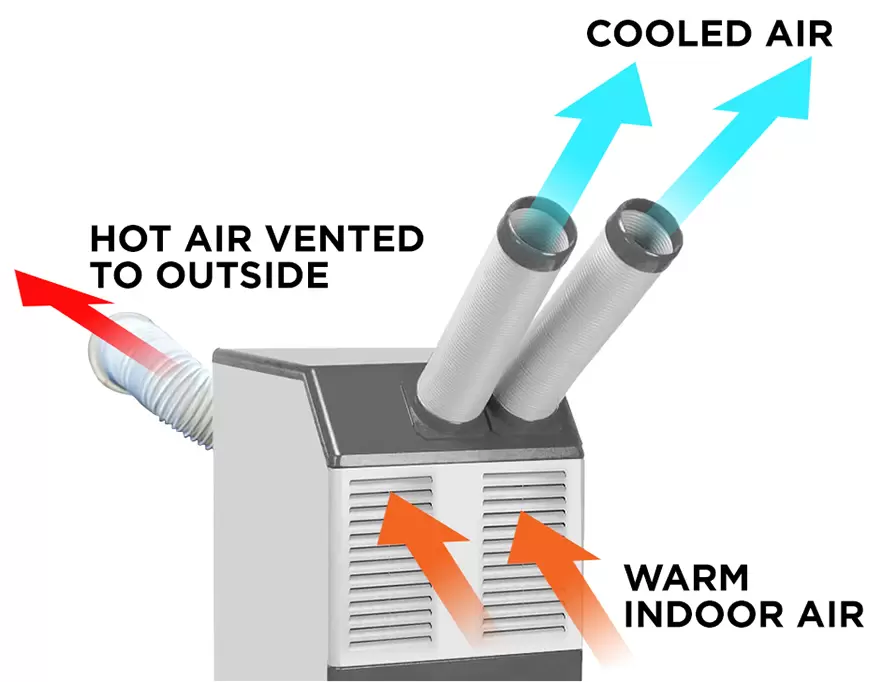
Close

Close

Portable air conditioners have the ability to remove heat and humidity from air inside a room and can be moved around and positioned wherever needed. They do not require any type of permanent installation, and because they are designed with wheels, they are mobile. However, while they do offer a fair amount of versatility and convenience, there are various limitations to their performance that should be considered. Read on to learn more about these systems and what to expect if you choose to invest in one.
Portable air conditioners are used in a wide array of different settings, locations, and environments. There are many reasons an individual or business may opt to use one for their cooling needs. From having a movable AC unit, to saving costs compared to the installation of a standard central AC unit, their various benefits make them a good choice for many situations.
Portable suck in warm air, cool this air & humidity, and then expels it through the vents at the back of the machine which is typically connected to a window using a duct. A standard air conditioner uses a refrigerant and uses special components to convert refrigerant from a gas, to a liquid, and back to a gas. The pressure is raised by the compressor and the refrigerant gas’s temperature sends it to the condenser coil where it is then converted into a liquid. After this, the refrigerant comes back in and enters an evaporator coil where it cools the coil. A fan blows air across the cold coil and into the room to cool the air. The heat is released outside.

With a portable AC, the entire system is contained within a single unit, which sits inside the room it is cooling. As the system runs, it produces continuous noise, which may be unsettling for some depending on the environment.
Despite being portable, these AC systems require certain space features for them to work properly. For example, they must be connected to a window for proper ventilation. When setting them up, they must be situated in a position that allows their airflow to channel into the room. Therefore, they should not be placed near walls or furniture that can block the delivery of cool air.
Like all other types of air conditioner systems, portable AC units require venting during use.
Unlike window air conditioning units, which use the external air to keep the coils cool, portable air conditioners must rely on the interior air. Portable air conditioners use the air from the room they are in to keep the interior mechanical system cool. As a result, the cooling system is less than ideal because it can create negative pressure, causing warm air from areas outside of the air-conditioned room to enter the cooled room. This is a tremendous waste of energy, and results in an environment that never filly reaches its maximum cool potential.
Different brands of portable AC units like LG, Whynter, Honeywell, Black & Decker, Global Industrial, Kwikkool, and others may have different designs, and therefore, use different parts for operation. However, the most essential parts of a portable air conditioner, that you will find are generally universal are:
Being portable, you can move these units from room to room so they can be set up wherever needed. However, portable air conditioners work using a duct, which is connected to the unit and a window, using a window kit, so the unit can vent externally. The kit will include a plastic panel with connectors, which will create a secure, custom fit. Typically, this can be done either horizontally or vertically, depending on the orientation of the window. Once the portable AC is set up, moving it is not advised.
They can be, however, there is a large range of power differentials between different makes and models. If you are interested in purchasing a portable AC, look for the BTU level on the model. This measurement is what shows how powerful the system is, and this will determine how well the unit can cool a room based on its size. The simplest way to understand this factor is the higher the BTU, the more area it can cool sufficiently.
If you opt to use a portable AC unit for cooling, it is important to know a few ways to enhance its performance. Here are some things to consider to ensure your portable AC performs optimally:
If you are considering using a portable air conditioner for your workplace or business, it may be wise to research the many options available to you. Depending on your needs, a portable air conditioner unit may or may not be adequate. Additionally, the climate you live in will play a part in the performance of the type of device you ultimately opt to invest in.
To learn more about your options, or to look further into the potential of the Power Breezer atomized evaporative cooling systems, reach out to our team!













